Exploring the Root–Soil Anchoring Dynamics of Bambusa pachinensis (Pachi Bamboo) Root System
Abstract
1. Introduction
2. Materials and Methods
2.1. Test Site
2.2. Pachi Bamboo
2.3. Mechanical Tests on Bamboo Root Systems and Testing Apparatus
3. Results
3.1. Geometric Characteristics of Pachi Bamboo Root Systems
3.2. Tensile Properties of Pachi Bamboo Roots
3.3. Pullout Resistance of Pachi Bamboo Root Systems in Soil
3.4. Shear Resistance of Pachi Bamboo Root Systems in Soils
3.5. Relationships Between the Characteristics of Pachi Bamboo and Root Reinforcement
3.5.1. Pullout Resistance of Pachi Bamboo Roots
3.5.2. Shear Resistance of Soils Permeated with Pachi Bamboo Root System
4. Discussion
4.1. Pachi Bamboo Root System Distribution
4.2. Tensile Property and Root Reinforcement
4.3. Exploring the Pachi Bamboo in Engineering Practice
4.4. Shortcomings and Outlook of the Study
5. Conclusions
Author Contributions
Funding
Data Availability Statement
Acknowledgments
Conflicts of Interest
References
- Waldron, L.J. The shear resistance of root-permeated homogeneous and stratified soil. Soil Sci. Soc. Am. J. 1977, 41, 843–849. [Google Scholar] [CrossRef]
- Gray, D.H.; Leiser, A.T. Biotechnical Slope Protection and Erosion Control; Van Nostrand Reinhold Co.: New York, NY, USA, 1982; 267p. [Google Scholar]
- Endo, T.; Tsuruta, T. Effects of tree root upon the shearing strengths of soils. Annu. Rep. Hokkaido Branch For. Place Exp. Stn. 1969, 18, 168–179. [Google Scholar]
- Hubble, T.C.T.; Docker, B.B.; Rutherfurd, I.D. The role of riparian trees in maintaining riverbank stability: A review of Australian experience and practice. Ecol. Eng. 2010, 36, 292–304. [Google Scholar] [CrossRef]
- Fan, C.-C.; Chen, Y.-W. The effect of root architecture on the shearing resistance of root-permeated soils. Ecol. Eng. 2010, 36, 813–826. [Google Scholar] [CrossRef]
- Waldron, L.J.; Dakessian, S. Soil reinforcement by roots: Calculation of increased soil shear strength from root properties. Soil Sci. 1981, 132, 427–435. [Google Scholar] [CrossRef]
- Schwarz, M.; Cohen, D.; Or, D. Root-soil mechanical interactions during pullout and failure of root bundles. J. Geophys. Res. 2010, 115, F04035. [Google Scholar] [CrossRef]
- O’Loughlin, C.L. An Investigation of the Stability of the Steepland Forest Soils in the Coast Mountains, Southwest British Columbia. Ph.D. Thesis, University of British Columbia, Vancouver, BC, Canada, 1972. [Google Scholar]
- Greenwood, J.R.; Norris, J.E.; Wint, J. Assessing the contribution of vegetation to slope stability. J. Geotech. Eng. 2004, 157, 199–208. [Google Scholar] [CrossRef]
- Genet, M.; Stokes, A.; Fourcaud, T.; Norris, J.E. The influence of plant diversity on slope stability in a moist evergreen deciduous forest. Ecol. Eng. 2010, 36, 265–275. [Google Scholar] [CrossRef]
- Fan, C.-C.; Lai, Y.-F. Influence of the spatial layout of vegetation on the stability of slopes. Plant Soil 2014, 377, 83–95. [Google Scholar] [CrossRef]
- Mao, Z.; Yang, M.; Bourrier, F.; Fourcaud, T. Evaluation of root reinforcement models using numerical modelling approaches. Plant Soil 2014, 381, 249–270. [Google Scholar] [CrossRef]
- Masi, E.B.; Tofani, V.; Rossi, G.; Cuomo, S.; Wu, W.; Salciarini, D.; Caporali, E.; Catani, F. Effects of roots cohesion on regional distributed slope stability modelling. Catena 2023, 222, 106853. [Google Scholar] [CrossRef]
- Dupuy, L.; Fourcaud, T.; Stokes, A. A numerical investigation into the influence of soil type and root architecture on tree anchorage. Plant Soil 2015, 278, 119–134. [Google Scholar] [CrossRef]
- Reubens, B.; Poesen, J.; Danjon, F.; Geudens, G.; Muys, B. The role of fine and coarse roots in shallow slope stability and soil erosion control with a focus on root system architecture: A review. Trees 2007, 21, 385–402. [Google Scholar] [CrossRef]
- Stokes, A.; Atger, C.; Bengough, A.G.; Fourcaud, T.; Sidle, R.C. Desirable plant root traits for protecting natural and engineered slopes against landslides. Plant Soil 2009, 324, 1–30. [Google Scholar] [CrossRef]
- Ennos, A.R. The anchorage of leek seedlings: The effect of root length and soil strength. Ann. Bot. 1990, 65, 409–416. [Google Scholar] [CrossRef]
- Bischetti, G.B.; De Cesare, G.; Mickovski, S.B.; Rauch, H.P.; Schwarz, M.; Stangl, R. Design and temporal issues in soil bioengineering structures for the stabilisation of shallow soil movements. Ecol. Eng. 2021, 169, 106309. [Google Scholar] [CrossRef]
- Zhou, B.; Fu, M.; Xie, J.; Yang, X.; Li, Z. Ecological functions of bamboo forest: Research and Application. J. For. Res. 2005, 16, 143–147. [Google Scholar]
- Mishra, G.; Giri, K.; Panday, S.; Kumar, R.; Bisht, N.S. Bamboo: Potential resource for eco-restoration of degraded lands. J. Biol. Earth Sci. 2014, 4, B130–B136. [Google Scholar]
- Tardio, G.; Mickovski, S.B.; Rauch, H.P.; Fernandes, J.P.; Acharya, M.S. The use of bamboo for erosion control and slope stabilization: Soil bioengineering works. In Bamboo: Current and Future Prospects; IntechOpen: London, UK, 2018; p. 105. [Google Scholar]
- Hairiah, K.; Widianto, W.; Suprayogo, D.; Van Noordwijk, M. Tree roots anchoring and binding soil: Reducing landslide risk in Indonesian agroforestry. Land 2020, 9, 256. [Google Scholar] [CrossRef]
- Lin, D.-G.; Liu, W.-T.; Lin, S.-H. Estimating the Effect of Shear Strength increment due to root on the stability of Makino bamboo forest slopeland. J. Geoeng. 2011, 6, 73–88. [Google Scholar]
- Wang, X.; Keplinger, T.; Gierlinger, N.; Burgert, I. Plant material features responsible for bamboo’s excellent mechanical performance: A comparison of tensile properties of bamboo and spruce at the tissue, fibre, and cell wall levels. Ann. Bot. 2014, 8, 1627–1635. [Google Scholar] [CrossRef] [PubMed]
- Li, Z.; Chen, C.; Mi, R.; Gan, W.; Hu, L. A strong, tough, and scalable structural material from fast-rowing bamboo. Adv. Mater. 2020, 32, 1906308. [Google Scholar] [CrossRef] [PubMed]
- Wang, Y.Y.; Wang, X.Q.; Li, Y.Q.; Huang, P.; Fu, S.Y. High-performance bamboo steel derived from natural bamboo. ACS Appl. Mater. Interfaces 2020, 13, 1431–1440. [Google Scholar] [CrossRef] [PubMed]
- Gao, X.; Zhu, D.; Fan, S.; Rahman, M.Z.; Guo, S.; Chen, F. A review of the structural and mechanical properties of bamboo fiber bundle and fiber/bundle reinforced composites. J. Mater. Res. Technol. 2022, 19, 1162–1190. [Google Scholar] [CrossRef]
- Zong, Y.; Chen, X.; Luo, X.; Su, Q.; Zhang, X.; Yan, Y.; Liu, H. Effect of Bamboo Culm Grading on the Properties of Flattened Bamboo Boards. Forests 2023, 14, 1120. [Google Scholar] [CrossRef]
- Rana, A.K.; Mandal, A.; Bandyopadhyay, S. Short jute fiber reinforced polypropylene composites: Effect of compatibiliser, impact modifier and fiber loading. Compos. Sci. Technol. 2003, 63, 801–806. [Google Scholar] [CrossRef]
- Shah, D.U. Developing plant fibre composites for structural applications by optimising composite parameters: A critical review. J. Mater. Sci. 2013, 48, 6083–6107. [Google Scholar] [CrossRef]
- Perremans, D.; Trujillo, E.; Ivens, J.; Van Vuure, A.W. Effect of discontinuities in bamboo fibre reinforced epoxy composites. Compos. Sci. Technol. 2018, 155, 50–57. [Google Scholar] [CrossRef]
- Ahmad, Z.; Upadhyay, A.; Ding, Y.; Emamverdian, A.; Shahzad, A. Bamboo: Origin, habitat, distributions and global perspective. In Biotechnological Advances in Bamboo; Ahmad, Z., Ding, Y., Shahzad, A., Eds.; Springer: Singapore, 2021. [Google Scholar] [CrossRef]
- Chen, C. Herbarium of Taiwan Forestry Research Institute. Version 1.8. Taiwan Forestry Research Institute. Occurrence Dataset 2021. Available online: https://www.gbif.org/occurrence/1821909071 (accessed on 5 March 2024).
- POWO Plants of the World Online. Facilitated by the Royal Botanic Gardens, Kew. Published on the Internet. 2024. Available online: https://powo.science.kew.org/taxon/urn:lsid:ipni.org:names:392450-1 (accessed on 16 July 2024).
- Canadell, J.; Jackson, R.B.; Ehleringer, J.R.; Mooney, H.A.; Sala, O.E.; Schulze, E.D. Maximum rooting depth of vegetation types at the global scale. Oecologia 1996, 108, 583–595. [Google Scholar] [CrossRef]
- Loades, K.W.; Bengough, A.G.; Bransby, M.F.; Hallett, P.D. Planting density influence on fibrous root reinforcement of soils. Ecol. Eng. 2010, 36, 276–284. [Google Scholar] [CrossRef]
- Cohen, D.; Schwarz, M. Tree-root control of shallow landslides. Earth Surf. Dynam. 2017, 5, 451–477. [Google Scholar] [CrossRef]
- Cislaghi, A.; Cohen, D.; Gasser, E.; Bischetti, G.B.; Schwarz, M. Field measurements of passive earth forces in steep, shallow, landslide-prone areas. J. Geophys. Res. Earth Surf. 2019, 124, 838–866. [Google Scholar] [CrossRef]
- Giadrossich, F.; Schwarz, M.; Cohen, D.; Cislaghi, A.; Vergani, C.; Hubble, T.; Phillips, C.; Stokes, A. Methods to measure the mechanical behaviour of tree roots: A review. Ecol. Eng. 2017, 109, 256–271. [Google Scholar] [CrossRef]
- Phillips, C.J.; Marden, M.; Lambie, S.; Watson, A.; Ross, C.; Fraser, S. Observations of below-ground characteristics of young redwood trees (Sequoia sempervirens) from two sites in New Zealand—Implications for erosion control. Plant Soil 2013, 363, 33–48. [Google Scholar] [CrossRef]
- Wu, T.H.; McKinell, W.P.; Swanston, D.N. Strength of tree roots and landslides on Prince of Wales Island, Alaska. Can. Geotech. J. 1979, 16, 19–33. [Google Scholar] [CrossRef]
- Deljouei, A.; Cislaghi, A.; Abdi, E.; Borz, S.A.; Majnounian, B.; Hales, T.C. Implications of hornbeam and beech root systems on slope stability: From field and laboratory measurements to modelling methods. Plant Soil 2023, 483, 547–572. [Google Scholar] [CrossRef]
- Vergani, C.; Chiaradia, E.A.; Bischetti, G.B. Variability in the tensile resistance of roots in Alpine forest tree species. Ecol. Eng. 2012, 46, 43–56. [Google Scholar] [CrossRef]
- Topp, C.N.; Benfey, P.N. Growth control of root architecture. In Plant Biotechnology and Agriculture; Altman, A., Hasegawa, P.M., Eds.; Prospects for the 21st Century; Academic Press: Amsterdam, The Netherlands, 2012. [Google Scholar] [CrossRef]
- Ma’ruf, M.F. Shear strength of Apus bamboo root reinforced soil. Ecol. Eng. 2012, 41, 84–86. [Google Scholar] [CrossRef]
- Mulyanti, J.; Hendra, D.; Megaprastio, B. Utilization of Bamboo Roots as Reinforcing Composite Materials for Light Vehicle Dashboards. J. Phys. 2024, 2739, 012031. [Google Scholar] [CrossRef]
- Cislaghi, A. Exploring the variability in elastic properties of roots in Alpine tree species. J. For. Sci. 2021, 67, 338–356. [Google Scholar] [CrossRef]
- Chimungu, J.G.; Loades, K.W.; Lynch, J.P. Root anatomical phenes predict root penetration ability and biomechanical properties in maize (Zea mays). J. Exp. Bot. 2015, 66, 3151–3162. [Google Scholar] [CrossRef] [PubMed]
- Teerawattanasuk, C.; Maneecharoen, J.; Bergado, D.T.; Voottipruex, P.; Le, G.L. Root strength measurements of Vetiver and Ruzi grasses. Lowl. Technol. Int. 2014, 16, 71–80. [Google Scholar] [CrossRef] [PubMed]
- Boldrin, D.; Bengough, A.G.; Lin, Z.; Loades, K.W. Root age influences failure location in grass species during mechanical testing. Plant Soil 2021, 461, 457–469. [Google Scholar] [CrossRef]
- Ekeoma, E.C.; Boldrin, D.; Loades, K.W.; Bengough, A.G. Drying of fibrous roots strengthens the negative power relation between biomechanical properties and diameter. Plant Soil 2021, 469, 321–334. [Google Scholar] [CrossRef]

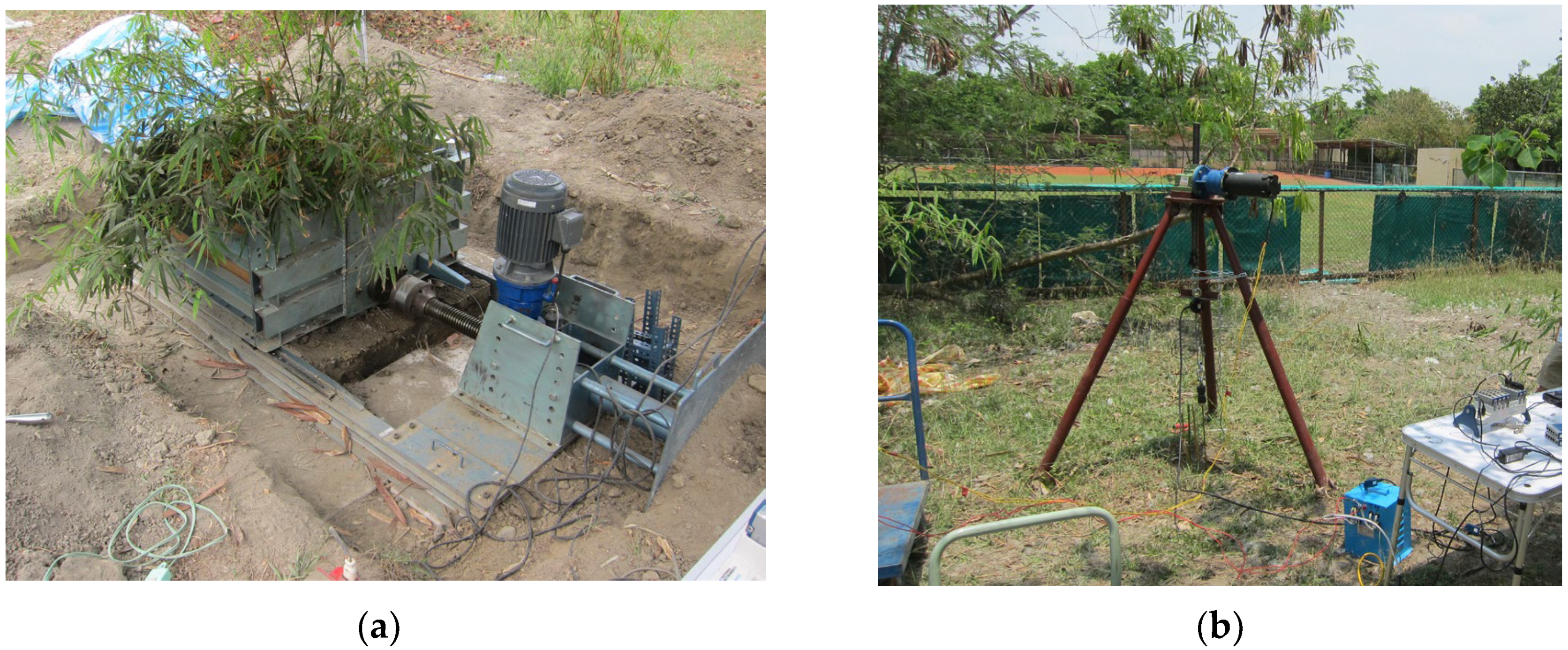
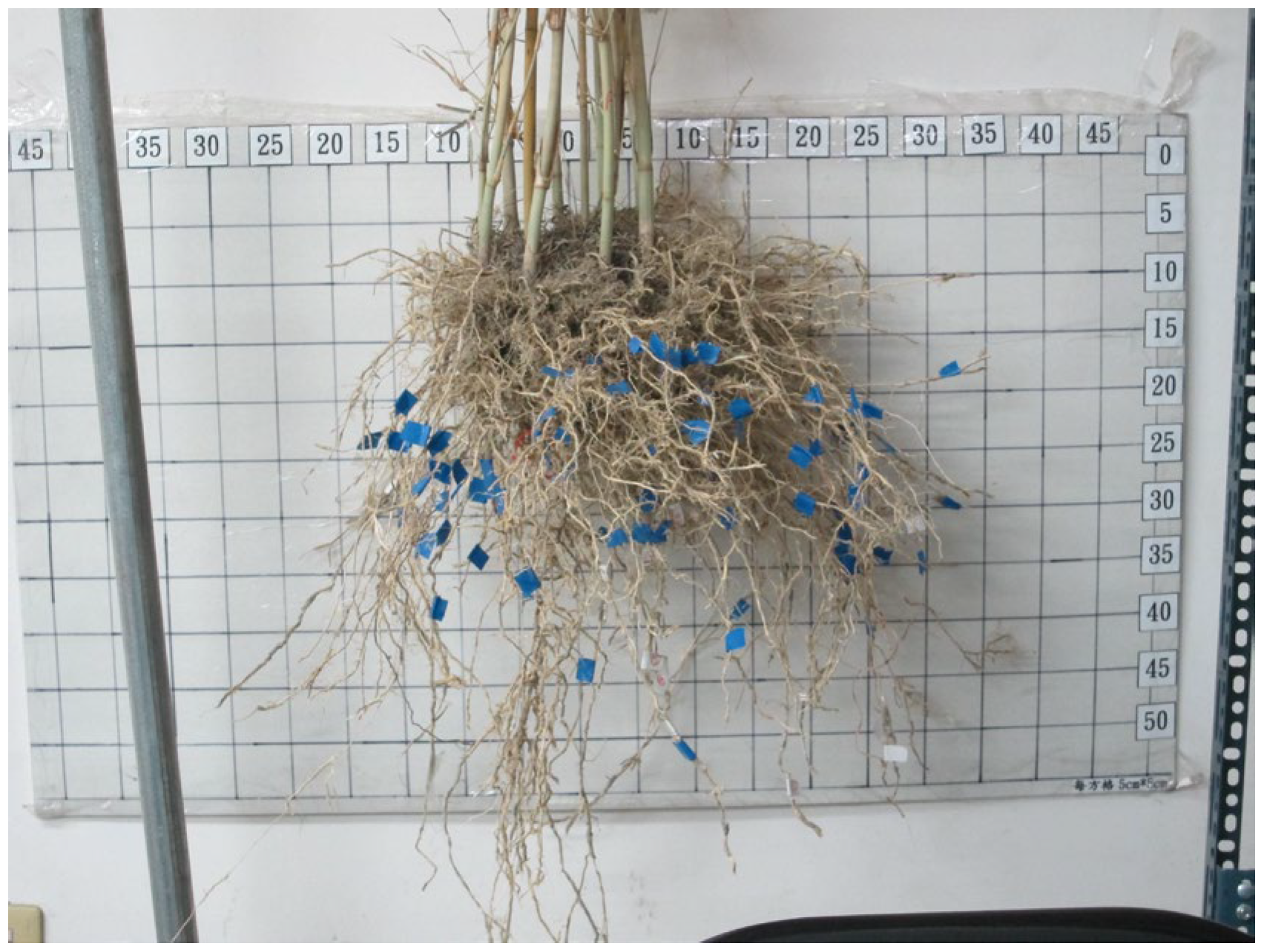
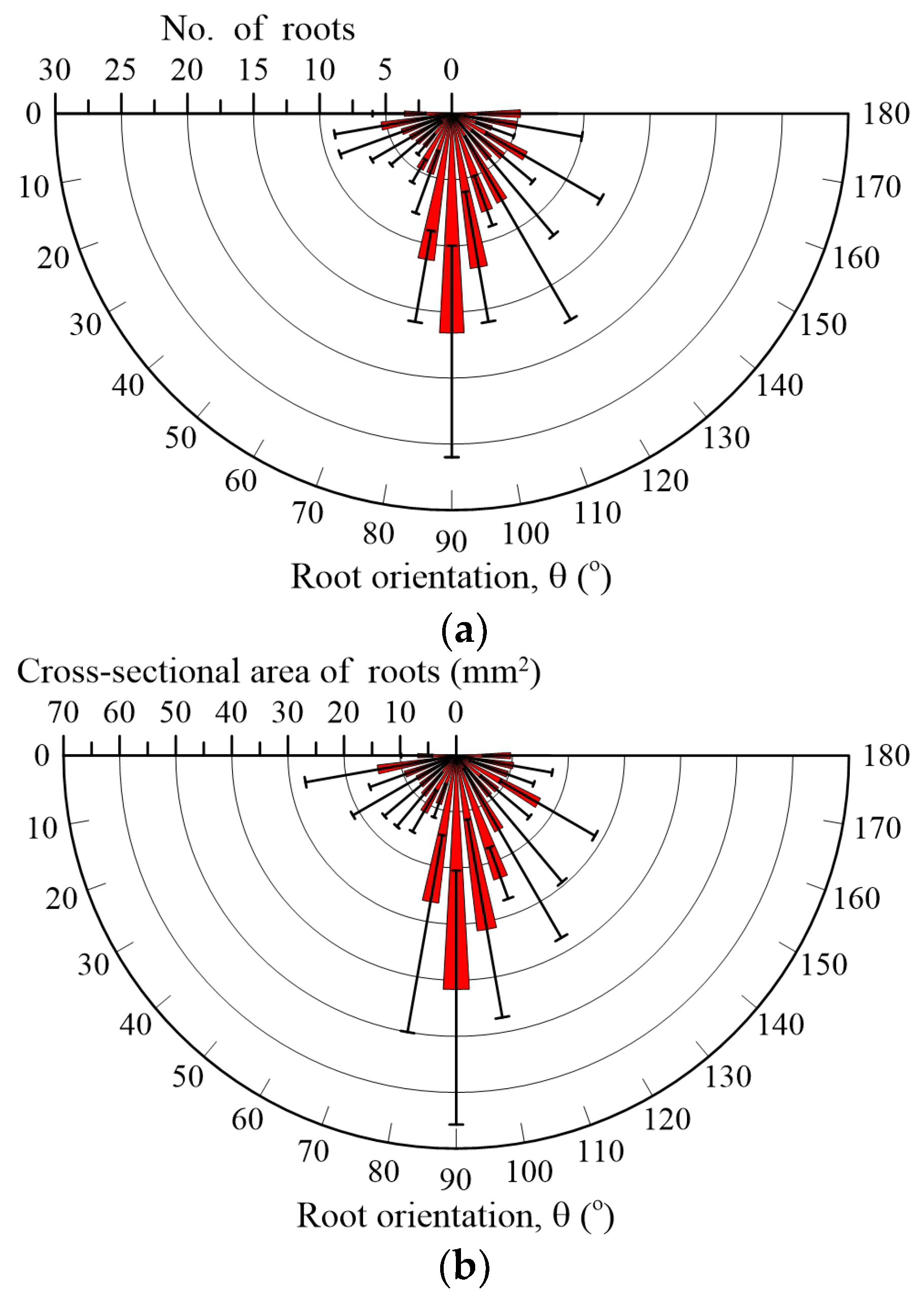

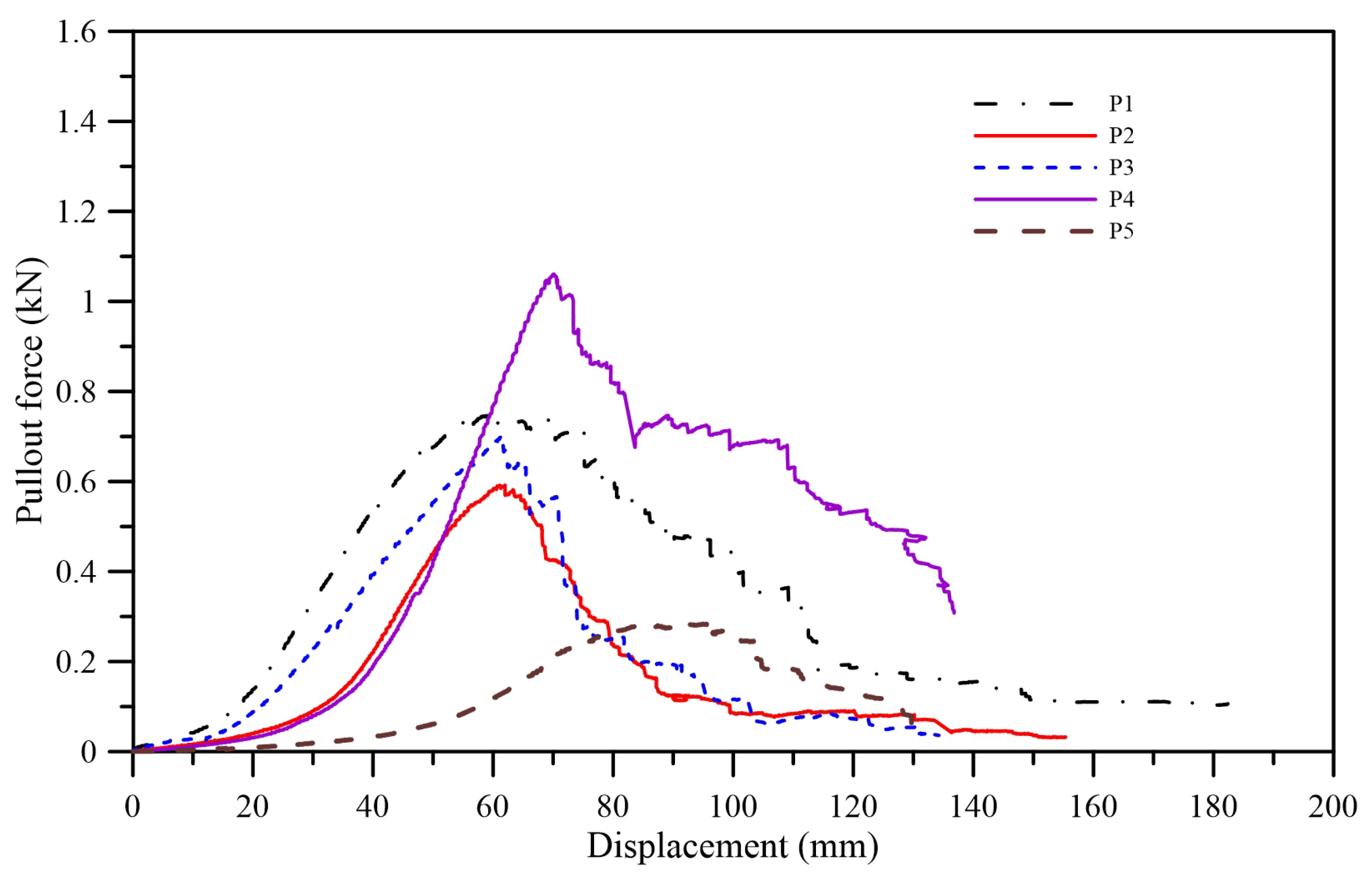

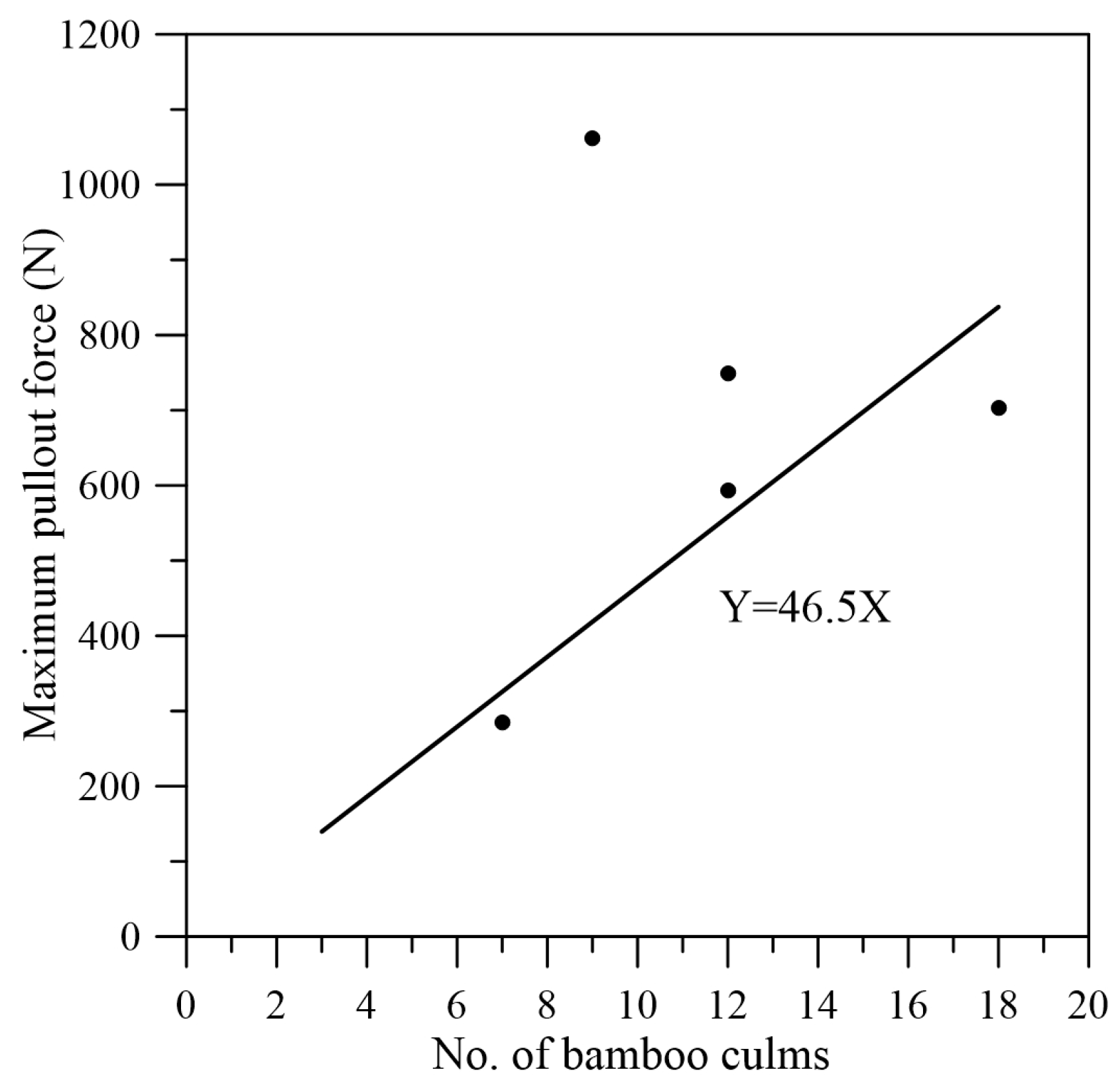
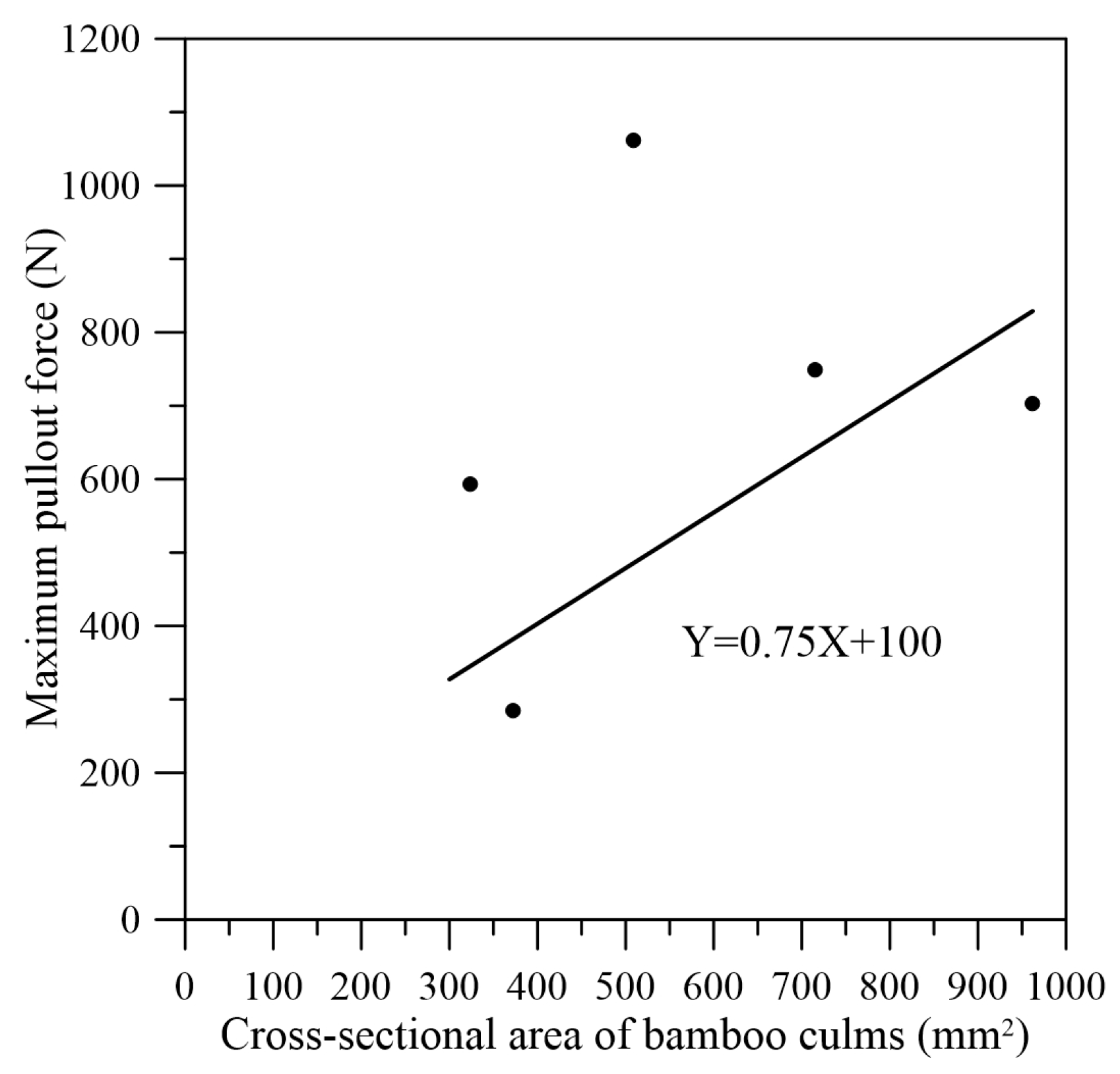
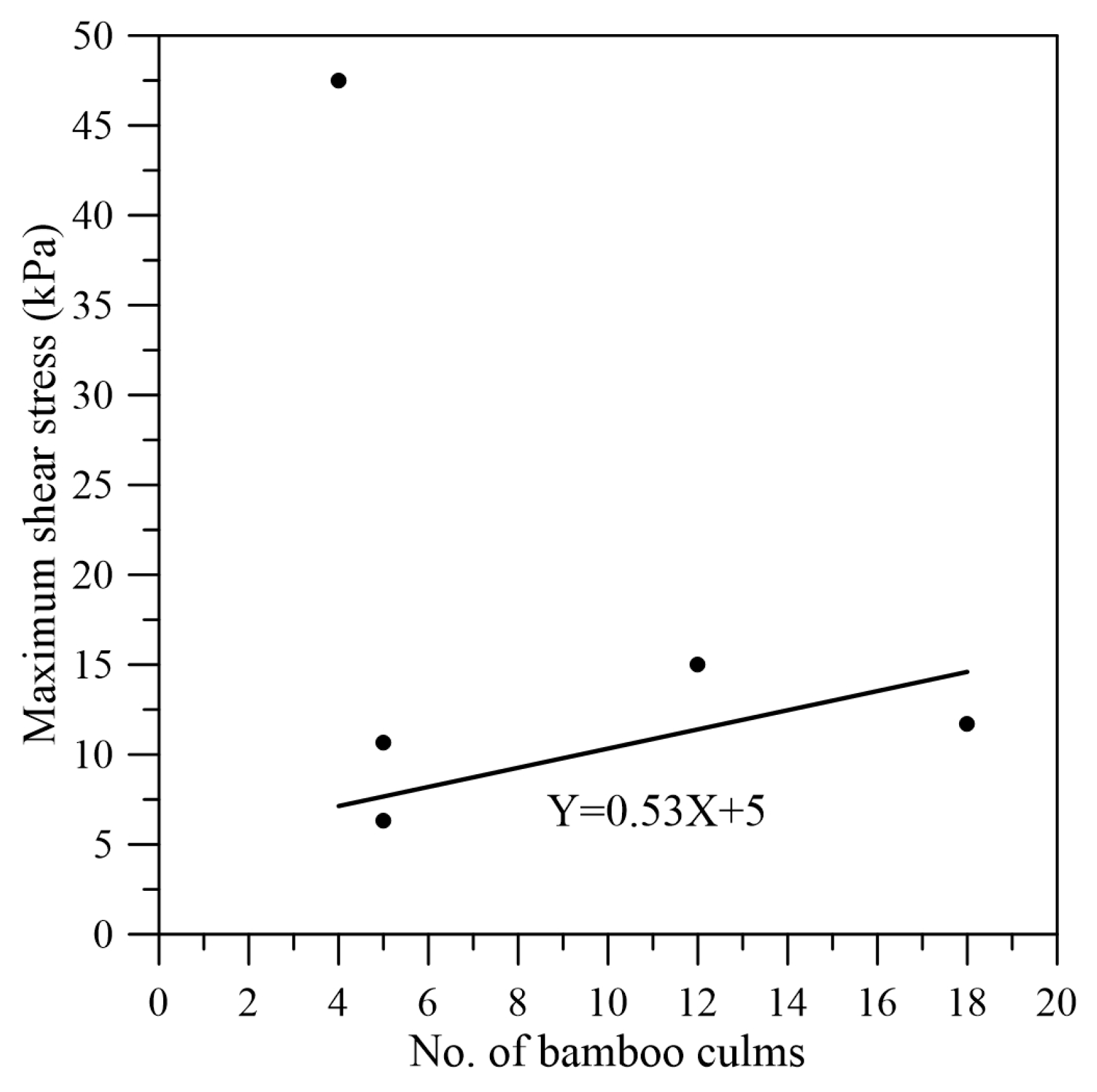
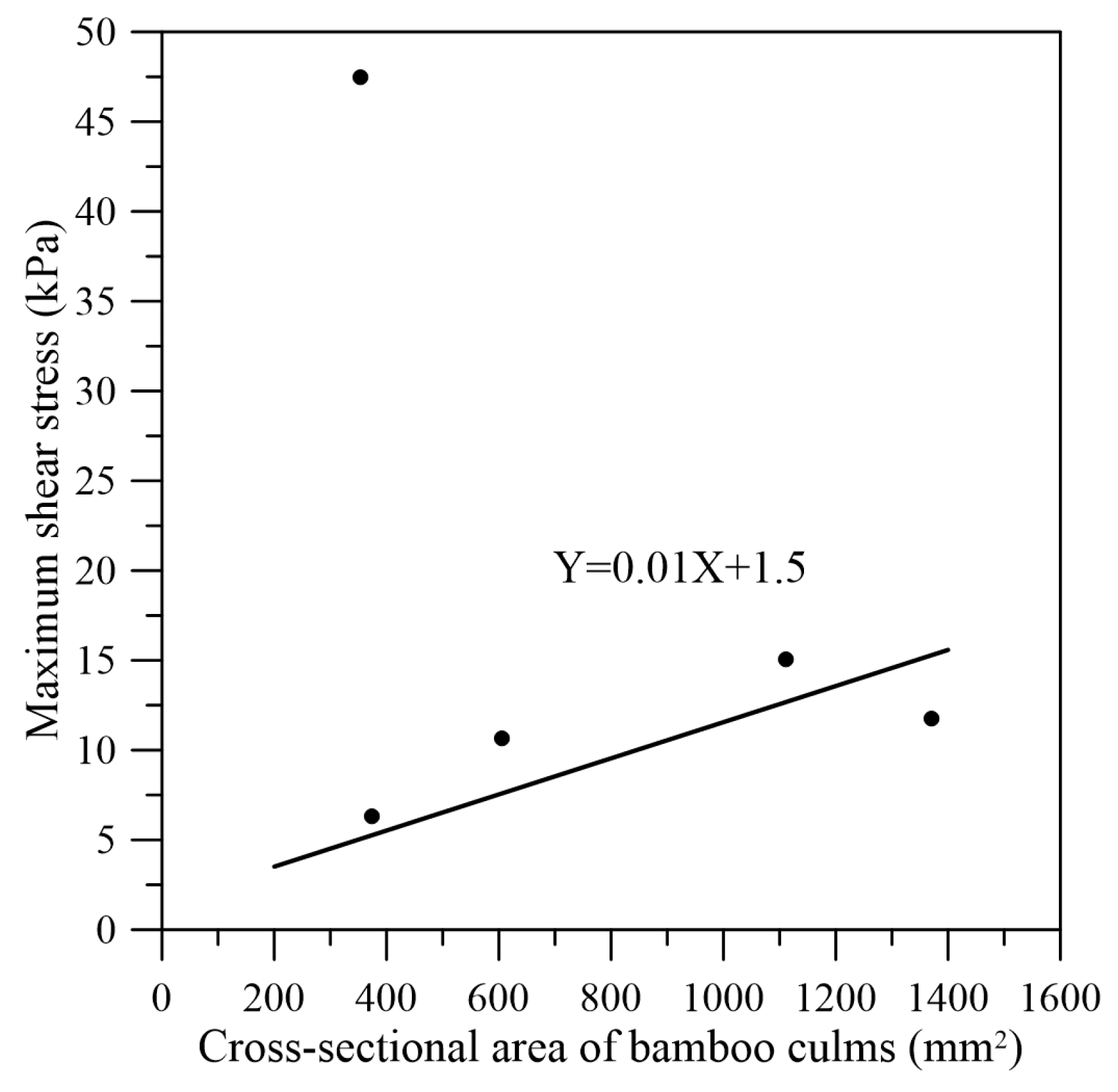
| Test No. | No. of Bamboo Culms | The Maximum Pullout Force (N) | The Cross-Sectional Area of Culms (mm2) | No. of Roots | No. of Near-Vertical Roots | The Cross-Sectional Area of Roots with Rupture (mm2) | The Cross-Sectional Area of Roots (mm2) |
|---|---|---|---|---|---|---|---|
| P1 | 12 | 748 | 715 | 185 | 105 | 109 | 419 |
| P2 | 12 | 592 | 324 | 102 | 60 | 208 | 223 |
| P3 | 18 | 703 | 962 | 99 | 45 | 194 | 200 |
| P4 | 9 | 1061 | 509 | 110 | 54 | 322 | 322 |
| P5 | 7 | 285 | 372 | 110 | 57 | 237 | 237 |
| Test No. | No. of Bamboo Culms | The Maximum Shear Stress (kPa) | The Cross-Sectional Area of Culms (mm2) | No. of Roots | No. of Near-Vertical Roots | The Cross-Sectional Area of Roots (mm2) | The Cross-Sectional Area of Near-Vertical Roots (mm2) |
|---|---|---|---|---|---|---|---|
| S1R | 4 | 47.5 | 353.4 | 48 | 21 | 115 | 21 |
| S2R | 5 | 6.3 | 373.1 | 19 | 9 | 102 | 46 |
| S3R | 5 | 10.7 | 605.1 | 17 | 8 | 52 | 32 |
| S4R | 18 | 11.7 | 1370 | 136 | 43 | 362 | 118 |
| S5R | 12 | 15 | 1111 | 69 | 39 | 185 | 90 |
Disclaimer/Publisher’s Note: The statements, opinions and data contained in all publications are solely those of the individual author(s) and contributor(s) and not of MDPI and/or the editor(s). MDPI and/or the editor(s) disclaim responsibility for any injury to people or property resulting from any ideas, methods, instructions or products referred to in the content. |
© 2025 by the authors. Licensee MDPI, Basel, Switzerland. This article is an open access article distributed under the terms and conditions of the Creative Commons Attribution (CC BY) license (https://creativecommons.org/licenses/by/4.0/).
Share and Cite
Fan, C.-C.; Chen, C.-H.; Chen, C. Exploring the Root–Soil Anchoring Dynamics of Bambusa pachinensis (Pachi Bamboo) Root System. Forests 2025, 16, 832. https://doi.org/10.3390/f16050832
Fan C-C, Chen C-H, Chen C. Exploring the Root–Soil Anchoring Dynamics of Bambusa pachinensis (Pachi Bamboo) Root System. Forests. 2025; 16(5):832. https://doi.org/10.3390/f16050832
Chicago/Turabian StyleFan, Chia-Cheng, Chung-Hao Chen, and Chunhsiung Chen. 2025. "Exploring the Root–Soil Anchoring Dynamics of Bambusa pachinensis (Pachi Bamboo) Root System" Forests 16, no. 5: 832. https://doi.org/10.3390/f16050832
APA StyleFan, C.-C., Chen, C.-H., & Chen, C. (2025). Exploring the Root–Soil Anchoring Dynamics of Bambusa pachinensis (Pachi Bamboo) Root System. Forests, 16(5), 832. https://doi.org/10.3390/f16050832







